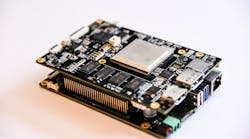AMD said it has completed its acquisition of Xilinx in a deal valued at $49 billion, adding momentum to its ambitions in the data center, telecom equipment, and other markets.
The Santa Clara, California-based company is intensifying its battle with a weakened Intel and a rapidly-growing NVIDIA in the data center market. The deal adds Xilinx’s field-programmable gate arrays (FPGAs) and systems-on-a-chip (SoCs) to AMD’s EPYC server CPUs and GPUs, giving it a wider range of chips to bring to new and existing customers in data centers, embedded, and telecom.
For AMD, the acquisition cements its status as one of the leaders of the U.S. semiconductor landscape, giving it the scale and product breadth to keep pace as the industry consolidates and customer needs change.
The all-stock deal was worth around $35 billion when AMD announced its plans in late 2020. But shares of the semiconductor giant have soared since then, pushing the value of the takeover to around $49 billion, making it the largest semiconductor deal in history.
The deal closes on the heels of NVIDIA's decision to abandon its plans to buy SoftBank-owned Arm for $40 billion, which fell apart amid stern pushback from regulators alleging the deal would be anti-competitive.
AMD's deal for Xilinx moved ahead with all the necessary regulatory approvals, including in China, which approved the deal last month.
Adding Momentum
The company has been on a tear for months as the pandemic has driven sales of personal computers and game consoles such as Microsoft’s Xbox Series X and Sony’s PlayStation 5 that use AMD-designed chips.
The company said revenue would be $21.5 billion in 2022, a record high, up more than 30% from a year ago.
AMD has also been taking market share from Intel in its stronghold of central processing chips used in PCs. It is also the second-largest vendor of high-end gaming graphics processors used in PCs behind NVIDIA.
Under CEO Lisa Su, AMD has seen its business selling server processors for data centers take off in recent years, too. The company has introduced new generations of server chips that challenge Intel's for the first time in years.
AMD is trying to keep the pressure on Intel, which has been struggling as its rival’s fortunes rise. Intel has been stung by problems in recent years with its manufacturing process, opening the door for AMD to take market share. AMD discarded its factories more than a decade ago in favor of using external foundries, including TSMC, which runs the world’s most advanced chip fabs. Xilinx also sources primarily from TSMC.
“The acquisition of Xilinx brings together a highly complementary set of products, customers, and markets combined with differentiated IP and world-class talent to create the industry’s high-performance and adaptive computing leader,” said Su.
She explained that the combination of Xilinx's FPGAs with its CPUs and GPUs will help it "capture a larger share of the approximately $135 billion market opportunity we see across cloud, edge, and intelligent devices.”
Data Center Dreams
The takeover could end up giving the biggest boost to AMD's data-center business. Executives said AMD is adding Xilinx to give it a new portfolio of server processors that it can, in turn, offer to existing customers.
AMD sells its EPYC server processors to all the major U.S. cloud-computing giants, including Microsoft, Amazon AWS, and Google, which use them to build out colossal data centers that they rent out to other corporations. Last year, AMD said it will also start supplying server processors to Meta Platforms, formerly Facebook, further eroding Intel's dominance in a category where it had 99% market share several years ago.
AMD's management has said that its market share in server CPUs currently stands at more than 10%.
Xilinx caters to many of the same customers as AMD in data centers. Xilinx's high-performance FPGAs and ACAPs can serve as accelerators for workloads such as networking, storage, security, and machine learning.
The deal also pushes AMD into the market for server networking cards also called Smart NICs, where it is up against NVIDIA's data processing units (DPUs) and Intel's infrastructure processing units (IPUs). These types of chips, which can be based on SoCs or FPGAs, offload networking, storage, security, and other chores from a server's CPU, saving CPU capacity for more prestigious workloads in the data center.
Complementary Parts
The deal also gives AMD a foothold in several markets where it was previously a smaller player or doesn't compete, including aerospace, defense, telecom, industrial, broadcast, automotive, and embedded.
Xilinx FPGAs are used in the latest U.S. combat plane, the Lockheed Martin F-35 fighter jet. The processors also can be found in base stations sold by telecom equipment makers Samsung Electronics and Ericsson.
Su will lead the combined company as CEO, while Xilinx's CEO Victor Peng will head up the newly formed Adaptive and Embedded Computing business unit, which will house Xilinx’s hardware and software assets.
AMD is also gaining access to Xilinx's army of engineers. The combined company will have more than 15,000 engineers, significantly expanding the scale of its research and development.
A wave of consolidation has been sweeping through the U.S. semiconductor industry, as companies look to round out their product portfolios. Chip development costs are also rising, giving a competitive edge to companies with larger checkbooks.
Analog Devices last year closed its more than $20 billion takeover of rival Maxim Integrated, giving it the scale to become a more formidable foe to Texas Instruments in the automotive and industrial markets.
AMD plans to wring out $300 million in cost savings out of the combination within 18 months.
